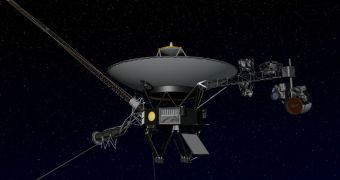Mission controllers at the NASA Jet Propulsion Laboratory (JPL), in Pasadena, California, want the Voyager 1 spacecraft to continue collecting and transmitting data until at least 2025. In order for the probe to do that, it needs to manage its dwindling power supplies extremely well.
The spacecraft has already been flying for more than 34 years and 4 months, and is currently located in the heliosheath. This is the outermost layer of the heliosphere, which is the area of influence our Sun has on its surrounding environment.
Beyond the heliosphere (and the heliosheath implicitly) lies the interstellar medium, which is the main target for both Voyager 1 and 2. The former, which launched on September 5, 1977, is now located around 119 astronomical units away from the Sun, and will most likely be the first spacecraft ever to exit the solar system.
An astronomical unit is the equivalent of the mean distance between the Sun and the Earth, or around 93 million miles (157 million kilometers). But getting to that point was not easy on the probe's power supplies, which is why there currently is a shortage of electricity.
The spacecraft is powered by three multihundred-watt radioisotope thermoelectric generators (MHW RTG), which together produced a total of 470 watts at launch. Slowly, but surely, that amount is decreasing, and mission controllers need to take that into account when planning the mission.
In order to save electricity, they recently turned off a heater that was destined to control the temperature of Voyager 1's ultraviolet spectrometer (UVS) instrument. This dropped temperatures in the instrument by around 23 degrees Celsius (41 degrees Fahrenheit).
The UVS is still collecting and returning data to Earth, through the NASA Deep Space Network (DSN). But the instrument is now operating at minus 79 degrees Celsius (minus 110 degrees Fahrenheit), the lowest temperature it's ever been subjected to.
Experts estimate that the shut-off will allow the spacecraft to save sufficient power so that it remains operational by 2025. However, this step is only a small part of a more complex plan. Even so, engineers will continue to monitor the performances of the UVS, ready to intervene if it stops working.

 14 DAY TRIAL //
14 DAY TRIAL //